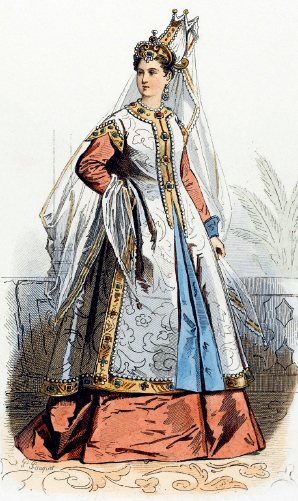Understanding World Societies:
Printed Page 491
INDIVIDUALS IN SOCIETY
Hürrem

Hürrem (1505?–1558) was born in the western Ukraine (then part of Poland), the daughter of a Ruthenian priest, and was given the Polish name Aleksandra Lisowska. When Tartars raided, they captured and enslaved her. In 1520 she was given as a gift to Suleiman on the occasion of his accession to the throne. The Venetian ambassador (probably relying on secondhand or thirdhand information) described her as “young, graceful, petite, but not beautiful.” She was given the Turkish name Hürrem, meaning “joyful.”
Hürrem apparently brought joy to Suleiman. Their first child was born in 1521. By 1525 they had four sons and a daughter; sources note that by that year Suleiman visited no other woman. But he waited eight or nine years before breaking Ottoman dynastic tradition by making Hürrem his legal wife, the first slave concubine so honored. For the rest of her life, Hürrem played a highly influential role in the political, diplomatic, and philanthropic life of the Ottoman state. First, great power flowed from her position as mother of the prince, the future sultan Selim II (r. 1566–
Hürrem was the sultan’s contact with her native Poland, which sent more embassies to Istanbul than any other power. Through her correspondence with King Sigismund I, peace between Poland and the Ottomans was maintained. When Sigismund II succeeded his father in 1548, Hürrem sent congratulations on his accession, along with two pairs of pajamas (originally a Hindu garment but commonly worn in southwestern Asia) and six handkerchiefs. Also, she sent the shah of Persia gold-
The enormous stipend that Suleiman gave Hürrem permitted her to participate in his vast building program. In Jerusalem (in the Ottoman province of Palestine) she founded a hospice for fifty-
Perhaps Hürrem tried to fulfill two functions hitherto distinct in Ottoman political theory: those of the sultan’s favorite and of mother of the prince. She also performed the conflicting roles of slave concubine and imperial wife. Many Turks resented Hürrem’s interference at court. They believed she was behind the execution of Suleiman’s popular son Mustafa on a charge of treason to make way for her own son to succeed as sultan.
Source: Leslie P. Peirce, The Imperial Harem: Women and Sovereignty in the Ottoman Empire (New York: Oxford University Press, 1993).
QUESTIONS FOR ANALYSIS
- How does Hürrem compare to powerful women in other places, such as Empress Wu in China, Isabella of Castile, Catherine de’ Medici of France, Elizabeth I of England, or any other you know about?
- What was Hürrem’s “nationality”? What role did it play in her life?

DOCUMENT PROJECT
How did Europeans view the Ottoman Empire? Examine a Habsburg ambassador’s impressions of the Ottoman Empire, and then complete a quiz and writing assignment based on the evidence and details from this chapter. See Document Project for Chapter 17